Introduction
The AllegroGraph 4.7 Web View (AGWebView) is a graphical user interface for exploring, querying, and managing AllegroGraph triple stores. AGWebView uses AllegroGraph's HTTP interface to provide these services through a web browser.
Using AGWebView you can:
- Browse available catalogs and repositories
- Create (also delete) a repository
- Load RDF data into a repository, or into a specific graph of a repository.
- Configure triple indices for a repository
- Set up free-text indexing for a repository
- Issue SPARQL and Prolog queries, which can be saved and reused
- Walk from query results to related triples and resources
- View and add namespaces
- Manage AllegroGraph users and "roles," and their access to repositories
- Capture a query as a web URL for embedding in applications
- Apply Prolog rules and functors to repositories
- Open sessions for commit and rollback.
- Activate RDFS++ reasoning on a repository
- Federate local and remote repositories into a single point of access
- Open telnet connections to AllegroGraph processes for debugging
- View graphs of "construct" and "describe" SPARQL query results
- Plot geospatial query results in a Google Maps display.
Starting AGWebView
AGWebView is a part of AllegroGraph server. When the server is running, AGWebView may be opened by typing the server's IP address and port number into the address field of a web browser:
http://localhost:10035 Logging in
If there is an AllegroGraph server listening on that port, AGWebView will respond immediately with a login form:

If you are exploring AGWebView for the first time, log in using the name and password of the AllegroGraph superuser you created during server installation. In Franz's documentation this user is usually described as "test" with password "xyzzy".
Once logged in you can create additional user accounts with different types of access and privileges.
Data Display Conventions
Much of the AGWebView interface is concerned with the "parts" of triples, which are composed of Uniform Resource Identifiers (URIs) and literal values.
In AGWebView, URIs consist of a namespace and a local name enclosed in angle-brackets <>.
<http://www.franz.com/examples#Alice> where http://www.franz.com/examples# is the namespace, and Alice is the local name.
By default, the AGWebView interface removes the namespace and displays only the local name. This produces query results that are easy to read:

For more detail, you can use a checkbox in the upper right corner of the AGWebView screen to turn on the "long parts" feature to see the full URIs:

AllegroGraph supports many types of literal values, as shown in our java tutorial. Literals generally appear as quoted strings in the AGWebView interface:

The "42" in the above image looks like a string but it is actually a xsd:long (a high-precision integer). To see the types of your literals, invoke the "long parts" feature again:

Managing Namespaces
The difference between the "short parts" and "long parts" displays shown above is the suppression of the URI namespace in the condensed displays. This makes the output easier to read.
We can also use namespaces for input. To make it easier to type in lengthy URIs, AllegroGraph provide a set of shared namespace abbreviations. These namespaces make it much easier to set up queries or to assert new triples by hand. These are the shared namespaces in AGWebView:
rdf: http://www.w3.org/1999/02/22-rdf-syntax-ns#
rdfs: http://www.w3.org/2000/01/rdf-schema#
owl: http://www.w3.org/2002/07/owl#
dc: http://purl.org/dc/elements/1.1/
dcterms: http://purl.org/dc/terms/
foaf: http://xmlns.com/foaf/0.1/
fti: http://franz.com/ns/allegrograph/2.2/textindex/
skos: http://www.w3.org/2004/02/skos/core# These namespaces are available to every user in every repository.
In addition to the shared namespaces, you can create custom namespaces in a repository. Some of these are shared, meaning that any user with access to the repository can use them. There are also private namespaces that are available only to a single user.
The list of shared namespaces is visible on the Repository Overview page. This is the list of all available namespaces, whether they are in use or not. The "add" link next to the list lets you add a new shared namespace to the repository.
You can also display the list of namespaces on the New Query page of a repository. Look for the "show my namespaces" link above the query. This is the list of shared and private namespaces that are available to that query. On this page the "add a namespace" link lets you create a new private namespace owned by the current user.
There is another "Namespaces" link in the banner of most AGWebView pages within a repository. This link opens a new page where you can select which of the default and shared namespaces should be active in the current repository. This display shows "Your namespaces" at the top, followed by "Standard namespaces" (the shared namespaces). On this form the shared namespaces have checkboxes. The checkboxes determine which namespaces will be active for the current user in the current repository. This lets people redefine namespaces without interfering with each other. The same abbreviation can be used for different namespaces, as long as only one of them is active at a time.
To create a namespace, simply click one of the "add namespace" links and then fill out the form:

Then to use the namespace, type it into an input field with the required colon (:) and the local name of the resource.

AGWebView will automatically expand the full URIs behind the scenes.
Managing Users
See Security for more information on this topic (the information about managing users is repeated in that document).
To open an AllegroGraph repository, you must supply an AllegroGraph user name and password. AllegroGraph users can differ in terms of repository access, ability to manage other user accounts, and permission to create sessions and to run arbitrary code.
This section describes user-related tasks and how to perform them. Many of these tasks can be performed on the User Management page. See the description of that page for a list of the controls found on it.
Initial Superuser
An initial superuser is created during the AllegroGraph server installation. This user typically appears in Franz documentation as user "test", password "xyzzy".
This superuser can create and manage other users, can start sessions, can evaluate arbitrary code, and has read/write access to all repositories in all catalogs.
Note that you want to have at least one superuser at all times, because only an AllegroGraph superuser can manage permissions and access for other accounts. It is possible to delete the last superuser and lock yourself out of user management, which is embarrassing but not fatal. You can re-create the original superuser by re-running the AllegroGraph server configuration script. This step has no impact on other user accounts.
Create a New User
On the User Management page, click the "add a user" link. This opens a form for the user name and password of the new user. User names and passwords are case-sensitive. You are not allowed to create a user without also specifying a password.
Set Permissions
Click the "edit" link next to the new user's name on the User Management page. You will see four checkboxes:

A Superuser automatically has all possible permissions and unlimited access. A superuser can also create, manage and delete other user accounts. Non-superusers cannot view or edit account settings.
A user with the Start Sessions permission can use the AllegroGraph features that require spawning a dedicated session, such as Transactions and Social Network Analysis (SNA). If you try to use these features without the appropriate permission, you'll encounter authentication errors. This permission should be withheld from users who do not need it because it spawns back-end processes that occupy memory and divert CPU cycles.
A user with permission to Evaluate Arbitrary Code can run Prolog "select" queries. This user can also do anything else that allows executing Lisp code, such as defining Prolog select generators for SNA, or doing eval-in-server, as well as loading server-side files. This permission should be withheld from users who do not need it, because it opens a window to potential server-side mischief.
The Control Replication permission can set up automatic replication of a triple store across multiple servers. This facilitates AllegroGraph's warm standby and point-in-time recovery features.
Access Control
You might want to limit a user's access to your repositories and catalogs. The Access Control form lets you do that.
Immediately under the permissions checkboxes you will find the Access Control form:

Select the access (read, write or both) and then select the catalog and repository. Asterisk (*) behaves as a wildcard in these fields. The forward slash (/) designates the root catalog. Click the "OK" link to add this permission. You can use the form repeatedly to add multiple permissions.
You will see the new permissions listed on the screen, just above the Access Control form:

The "remove" link deletes the permission.
Filtering out triples
You can set up filters which limit access to specific triples (those with specified subject, predicate, object, or graph). See the discussion of Security filtering in Security Implementation for more information.
Managing Roles
A "role" is a predefined set of permissions and access settings. Roles let us centrally manage the permissions and access of a class of users. Security experts prefer to manage access through roles because it lets them respond quickly to an emergency. A single mouse-click on a role can revoke permissions from scores of users at the same time. To make the same change in all the individual user accounts would take too much time.
To create a role, go to the User Management page and scroll down to the Roles section. Click the "add a role" link. Enter the name of the new role in the resulting form. Note that role names should be descriptive and specific, because they become entries on a potentially long list of available roles.
Once the role has been created, give it permissions and access just as if it were a user account.

To apply a role to a user account, click the "edit" link for that account.

Select the role from the list and click the "OK" link. The user's local permissions and access indicators will not change, but he/she will have the full powers of the role.
Anonymous Access
If you create a user named "anonymous" (the case is significant, all lowercase), AGWebView will enable anonymous login. This is the only user account that can be created without a password.
On the User Management page, click the "add a user" link and type "anonymous" in the __Username__ field. Then click the "OK" button.
From this point on, AGWebView will automatically log in the anonymous user each time you connect to the server. This makes AGWebView available to anyone, but only within the limits imposed by the permissions and access settings of the anonymous account. Be sure to give the anonymous account read access to at least one repository or the visitors won't be able to see anything.
Anonymous access does not prevent you from logging in as another user. Look for the "User: anonymous > login" menu item in order to log in to your account.

Self-Enrollment
AGWebView can permit otherwise anonymous users to self-enroll by registering usernames and passwords for themselves. These self-enrolled users have the same permissions and access as the anonymous user, but they can also have private namespaces and their own saved queries.
A superuser enables this feature in the Site Settings section of the Root Catalog page, by clicking the "Allow" link.

When self-registration is allowed, there is a "User anonymous > register" menu item in the page banner. This link opens a form for creating a new user. The new user is automatically logged in after registration.
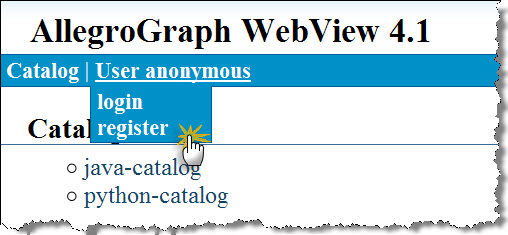
SPARQL Queries
The reader might appreciate some "seed" queries to help get started with SPARQL. Note the use of curly braces {} instead of parentheses () in SPARQL queries.
"Show the subject and object values from fifty rdf:type triples." This returns only the values you ask for.
select ?s ?o where {?s rdf:type ?o} limit 50 "Construct fifty new triples from values found in existing triples." This returns a set of actual triples, sometimes called a "graph."
construct {?s ?p ?o} where {?s ?p ?o} limit 50 "Describe a resource to me." Note that this query returns all triples that describe a specific resource, including those obtained by traversing a blank node.
describe ?s where {?s ?p ?o} limit 1 Prolog Queries
The user account must have permission to "execute arbitrary code" in order to execute a Prolog query.
AllegroGraph provides "select" queries as an extension to its internal Prolog language. This is a simple Prolog query. Note the use of parentheses () instead of curly braces {}, and that the triple patterns begins with a "q". Also, namespace abbreviations must be preceeded by a bang (!) character.
(select (?s ?o) (:limit 10) (q ?s !rdf:type ?o) ) This query returns subject and object values for ten triples that contain an rdf:type predicate.
Prolog "select" queries are the portal to AllegroGraph's geospatial and social-network features.
Session Specifications
The AGWebView interface allows the advanced user to create a new "session." It offers you an empty text field (on the Root Catalog page) to enter your "session specification."
This is a powerful tool for creating complex federated triple stores, with reasoning and graph filtering applied to the individual stores of the federation.
For instance, this specification federates a reasoning version of store "A" in the root catalog with a reasoning version of the "http://example.com/graph1" graph of store "B" in the "public" catalog:
<A>[rdfs++] + <public:B>{<http://example.com/graph1>}[rdfs++] In a session specification, local stores are written as <catalog:name>, or just <name> for stores in the root catalog.
Remote stores are written by putting their URL between < and >.
Multiple stores can be federated by putting plus signs (+) between them. For example, <store1> + <store2>.
To apply a reasoner to a store, write [rdfs++] or [hasvalue] after it.
To create a filtered store, write the URIs of the participating graphs between braces {}, using null to indicate the default graph.
The Session Specification field has an "autocommit" checkbox next to it. Uncheck this box to create transaction semantics, where you can manually issue "commit" and "rollback" actions as needed. Look for them in the Session menu, up in the page banner.
Free-Text Indices
AllegroGraph supports multiple free-text indices, each targeted as narrowly as you like on specific fields of specific predicates.
The form for creating a free-text index is on the Free-Text Indices page.
Each free-text index has a name, so you can apply it to a query or perform maintenance on it.
Each index works with one or more specific predicates, including an option to index all predicates.
An index can include all literals, no literals, or specific types of literals.
An index can process the full URI of a resource, just the local name of the resource (after the # or /), or it can ignore resource URIs entirely.
An index can focus on any combination of the four parts of a "triple:" the subject, predicate, object, and graph.
Stop words (ignored words) may be specified, or the index can use a default list of stop words.
In addition, an index can make use of word filters such as stem.english or drop-accents.
Google Maps Display
If your query results are in AllegroGraph's geolocation format, and if you have provided AGWebView with a Google Maps key, then AGWebView will offer to display the results as a map, like this one:
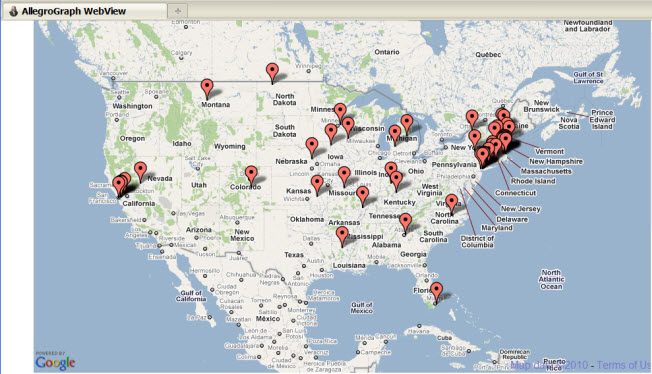
AllegroGraph geospatial coordinates generally resemble this example:
"+481200.00273+0162212.00273"^^<http://franz.com/ns/allegrograph/3.0/geospatial/spherical/degrees/-180.0/180.0/-90.0/90.0/1> AGWebView can map the results of any query that returns geospatial coordinates as the object values of the query.
WebView User Interface
This section provides a page-by-page summary of the AGWebView user interface.
Banner
There is a blue header across the top of most AGWebView pages. This banner displays the name of the logged-in user, and offers context-specific controls that let you "back out" to previous pages or to access general functions such as "logout". The illustration just shows a possible banner. Because available choices are displayed according to the context, not all choices are shown in this illustration, although you will see many in banners in other illustrations.

- <<
- The << symbol lets you go "back" a level in the hierarchy of AGWebView pages.
- Admin
- This is a drop-down menu offering three options to the AllegroGraph superuser:
- processes: This link opens the Processes page.
- users: This link opens the User Management page.
- initfile: This link opens the Initfile editing page.
- User
- This is a menu that drops down from the name of the current user offering:
- logout: The current user logs out.
- delete: The current user has an opportunity to delete his/her own account.
- Reasoning
- If checked, turn on RDFS++ reasoning for queries on this repository.
- Long parts
- If checked, display fully-expanded URIs in the query results.
- Contexts
- If checked, display the graph URI as the fourth element of each returned "triple."
- Overview
- This link moves the focus to the Repository Overview page for the current repository.
- Queries
- When viewing a repository, query options appear as a menu in the banner.
- new: Create a new query.
- saved: Select from a list of saved queries.
- recent: Re-run a recent query, whether saved or not.
- text: Run a text query.
- Namespaces
- The namespaces link in the banner leads to the Namespace Selection page.
- Session
- When you have opened a transaction session in a repository, a session menu appears in the banner.
- commit lets you take all of the triples you have loaded or created up to this point, and add them permanently to the repository.
- rollback lets you discard all uncommitted triples, presumably because your load was interrupted and you want to start over.
- close terminates the session.
User Management Page
From the top-level Root Catalog page of the AGWebView interface, scroll down to the Site Settings section. Click the "user accounts" link to open the User Management page. You must be logged in as an AllegroGraph superuser in order to view this page.
See the Managing Users section for a task-based explanation of user management.
- Add a User
- This link opens a form for the name and password of a new user.
- Delete
- You can delete a user account.
- Edit
- Each user account has an "edit" link that opens up controls for settings permissions and access.
- Change Password
- Click here to change the user's password.
- Roles: Add
- If user roles have been defined, you can use this control to associate the current user with a role. Select the role from the list and click the OK link.
- Superuser
- A superuser has full access to all repositories, can execute arbitrary code, and can manage user accounts.
- Start sessions
- This checkbox gives the account permission to start sessions. A "session" is an independent AllegroGraph back end that supports transaction semantics and Prolog queries.
- Evaluate arbitrary code
- This checkbox gives the account permission to execute Prolog queries, which opens a window to executing arbitrary code on the server.
- Grant read/write on catalog/repository.
- This group of controls lets you grant an account read and/or write access to specific repositories. "*" is a wildcard for "all". "/" means the root catalog.
- Remove
- The "remove" link lets you revoke repository access after it has been granted.
- Add a Role
- This link lets you name a new role.
- Delete Role
- Each role has a "delete" link that lets you remove the role.
- Edit Role
- You can edit a role to grant permissions and access to it, just like you would for a user account.
Root Catalog Page
The Root Catalog page is the top-level page for the AGWebView interface. We call it the "Root Catalog" page because it lists the repositories of the root catalog. It also lists the names of any named (non-root) catalogs that are present. This page lets you choose a triple store to manage.
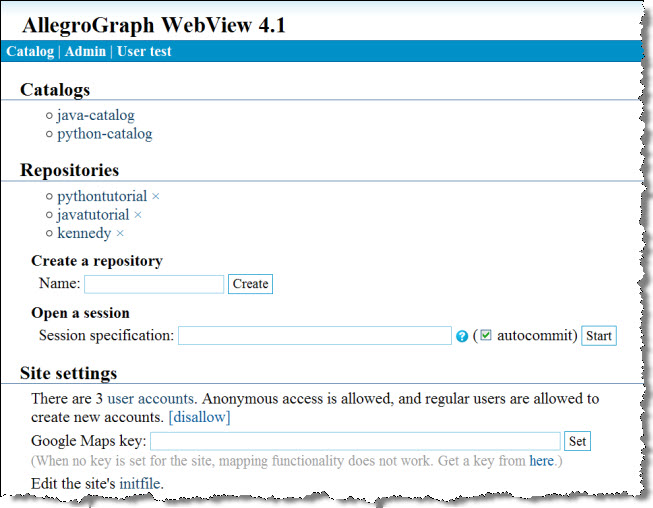
This is the page you see when you log into AGWebView. Later you can return to this page by clicking the "<<" link in the page banner until the focus returns to the top level.
- Catalogs
- These are the non-root catalogs of the system. Click on one to see the repositories it contains.
- Repositories
- These are the repositories of the root catalog.
- Create a Repository
- Create a new repository in the root catalog.
- Open a session
- This field lets you create an arbitrarily complex federated store. See Session Specification earlier in this document.
- Site Settings
- This section links to miscellaneous controls that are described individually below.
- User Accounts
- Follow this link to the User Management page for managing user accounts.
- Allow/Disallow
- This link is only visible to a superuser. It toggles, giving anonymous users the ability to create their own accounts. These accounts have the same privileges and access as the anonymous account. In this fashion, otherwise anonymous users can set up their own namespace lists, and can save their own queries.
- Google Maps Key
- This field lets you paste in a Google Maps key, which in turn lets AGWebView generate map displays of query results. This feature presumes that the triple store contains data that conforms to AllegroGraph's geospatial location format. (See the section on Google Maps.) Google requires that you provide a URL for the web site where the maps will appear. Use the URL that you use to open AGWebView. (The URL "localhost:10035" usually works.) Paste the resulting Google Maps key into this field.
- Initfile
- This feature is available only to superusers. The "Edit the site's initfile" link opens a large edit field containing the text of the AllegroGraph server's initialization file, which is
/data/settings/initfile. This code is run by AllegroGraph server each time a new session is opened. It lets you load Prolog functor definitions to use with your Prolog queries.
Named Catalog Page
From the top-level Root Catalog page, click on any non-root catalog. This opens a Named Catalog page. This page lists all the repositories that are available within that catalog. Note that this page has the name of a specific catalog at the top.
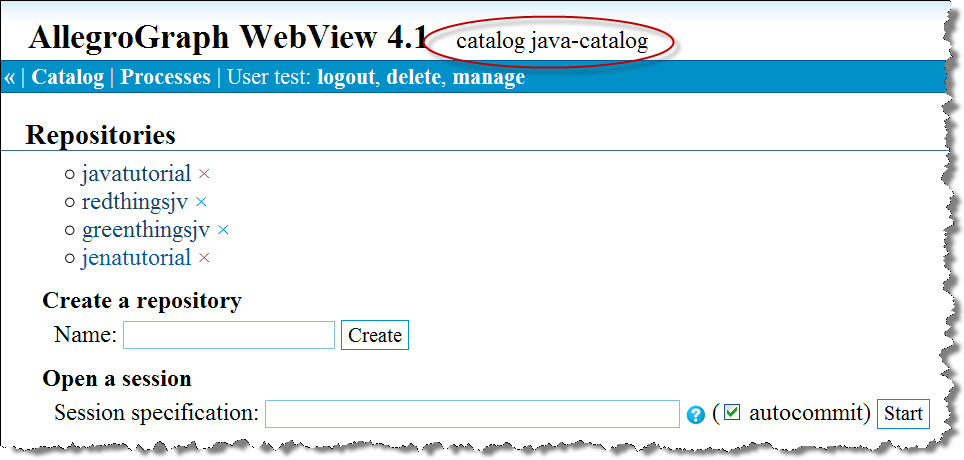
- Repositories
- These are the available repositories within this catalog. Click on one to see its Repository Overview page.
- Create a Repository
- Create a new repository in the current catalog.
- Open a session
- This field lets you create an arbitrarily complex federated store. See Session Specifications earlier in this document.
Repository Overview Page
The Repository Overview page gives you access to a specific repository within a specific catalog. The name of the repository is posted at the top of the page:
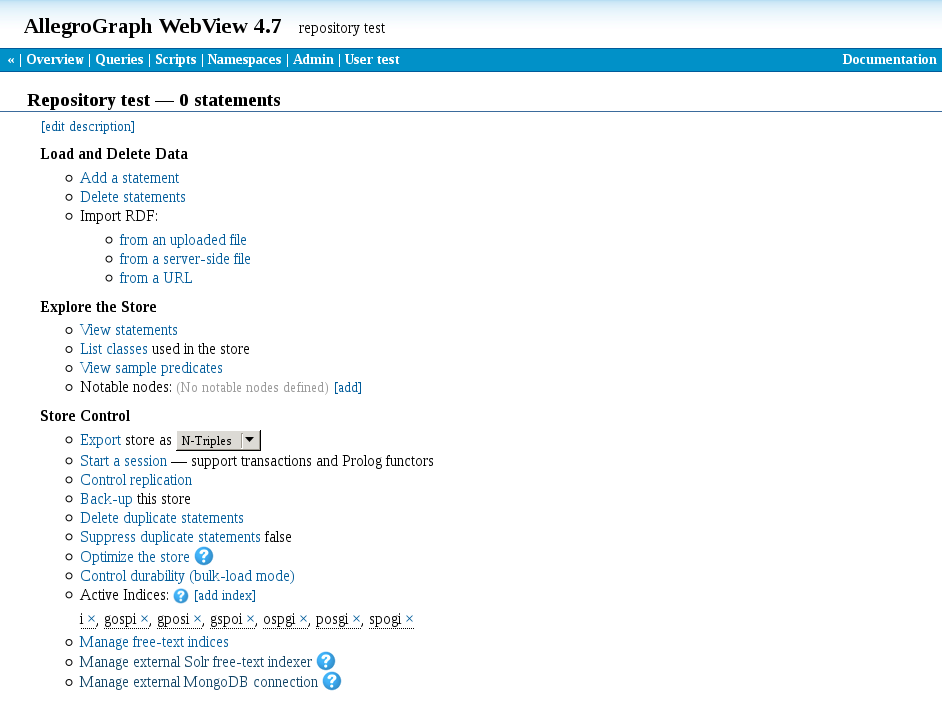
- Edit Description
- This link lets you create a brief text description of the repository.
- Load and Delete Data
- This group of choices allows you to add or triples.
- Add a Statement
- This link opens a form to let you enter the subject, predicate, and object URIs of a new triple. You may optionally add a context (graph) URI.

- Delete Statements
- Enter any combination of URIs, wildcards, and literals into the fields of the form. Click OK to delete all matching statements from the triple store. Caution: There is no way to undo this action.
- Import RDF
- The choices allow you to select a file and load it into the repository. It can be a local file, a server-side file, or a file reached by a URL on the Internet.

- Explore the Store
- These choices allow you to view triples in the store.
- View Statements
- This link runs an unrestricted SPARQL query and returns the first 100 triples it finds. The purpose of this feature is to give you a quick look into the triple store.
- List classes
- This is another feature that lets you take a quick look at a new triple store. It runs a SPARQL query that lists the rdf:type classes in the repository.
- View sample predicates
- This feature runs a SPARQL query that lists the first 100 predicates found in the triple store.
- Notable Nodes
- You can enter the subject URI of a resource of special interest. The URI then appears as a link on the page. Clicking this link takes you to a query-results page that shows predicate-object pairs from the target resources, plus all triples that use this URI as a predicate, and all triples that contain this URI as the object.

- Store Control
- These choices allow you to manipulate a store.
- Export
- You can dump the triple store to a file, using any of these RDF formats:
- N-Triples
- N-Quads
- RDF/XML
- TriX
- Start a Session
- This link starts a dedicated session in this repository, which establishes transaction semantics. A Session menu will appear in the banner, offering Commit and Rollback links. Commit lets you take all of the triples you have loaded or created up to this point, and add them permanently to the repository. Rollback lets you discard all uncommitted triples, presumably because the load was interrupted and you want to start over. The menu also offers a Close link, which ends the session.
- Control Replication
- See the document on Replication and Warm Standby. This link opens the Replication page.
- Active Indices
- This is the list of active triple indices for this repository. Click on an "x" icon to delete an index, or use the Add Index link to add one.
- Manage free-text indices
- This link takes you to the Free-Text Indices page. See the section on Free-Text Indexing, above. Once you have created a free-text index, you can use the Queries menu to initiate a text search.
- Manage external Solr free-text indexer
- This link lets you set up a connection to the Apache Solr full-text indexer from an AllegroGraph repository. See Solr Text Index.
- Manage external MongoDB connection
- This link lets you set up a connection to a MongoDB from an AllegroGraph repository. See MongoDB interface.
Free-Text Indices Page
One reaches the Free-Text Indices page by clicking "View free-text indices for this store" on the Repository Overview page.
To create an index, type its name into the field. Remember that there might be many indexes, so the name should be fairly specific. Click the "Create" link.
Once you have named and created the index, you have to set a variety of options that tell AllegroGraph what to put in this index. See the Free-Text Indices section for a discussion of these options.
When you create a new index or edit the parameters of an old one, AllegroGraph will reload the triples to bring the index up to date.
New Query Page
From the Repository Overview page, click the New link in the Queries menu. This exposes a page where you can edit a SPARQL or Prolog query to run against this repository.
See the sections on SPARQL Queries and Prolog Queries for examples queries to get you started.
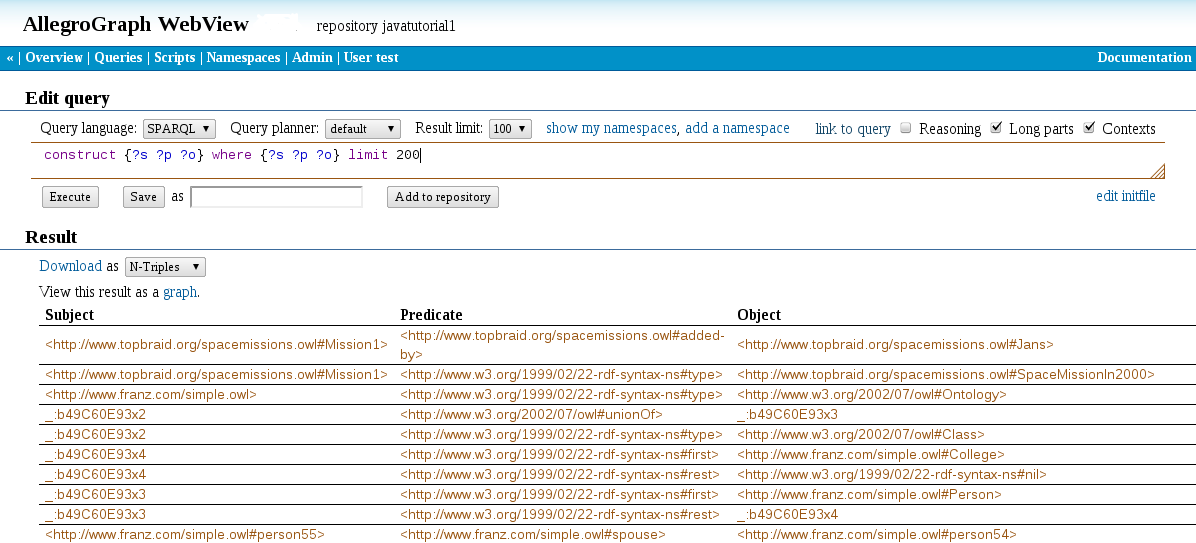
This page lets you edit a new SPARQL or Prolog query and test it against the triple store.
- Query language
- This page accepts SPARQL queries from all users. Users with permission to execute arbitrary code will be offered the option to use a Prolog query instead.
- Show my namespaces
- Click this link to view the table of namespaces that are available to the current query. This could be a mix of shared and private namespaces.
- Add a namespace
- This like lets you enter a new, private namespace to use in this query.
- Bulk Input
- When you click the "Add a namespace" link, one of your options is a "Bulk Input" button. Click this button to open an edit field where you can paste in many namespaces in one operation. Use one namespace per line, in a format like "ex http://example.com/" or "ex: http://example.com/". (Note that bulk is used by two utilities in different ways. In data loading (see Data Loading), bulk means loading data without transaction logging. In Sesame and Jena and also here it mean processing several statements at once but is not related to transaction logging or loading.)
- Query Edit Field
- This is the unlabeled field where you type in the text of your query. Note that you can adjust the size of the field by using the mouse to "grab" the handle at the lower right corner of the field.
- Link to query
- Click this link to generate a URL that invokes this query on this repository. You can publish this URL or embed it in software. Copy the URL from the browser's address field. Note that this URL requires anonymous access. If there is no anonymous account, AGWebView will require the user to log in.
- Execute
- The Execute button runs the query. A table of results will appear in the lower half of the page.
- Save As
- You can save a private copy of a query for later reuse. Give it a name and then click the Save button. To find this query again, click the saved link in the Queries menu in the page banner. (This feature is available to superusers, normal users, and self-registered users, but not to anonymous users.)
- Add to Repository
- You can also "save" a query by adding it to the Repository Overview page as a link to a "Pre-defined Query." To do this, give the query a name and click the "Add to Repository" button. (Superusers can add a query to the Repository Overview page. All users, including anonymous, can then use it.)
- Edit Initfile
- This feature is available only to superusers. The "edit initfile" link opens a large edit field containing the text of the AllegroGraph server's initialization file, which is
/data/settings/initfile. This code is run by AllegroGraph server each time a new session is opened. It lets you load Prolog functor definitions to use with your Prolog queries. - Result
- This is a table of search results. Each URI in the table is a link to a page of information about how that URI is used in the triple store.
- Download as
- If your query produced triples as output (such as a SPARQL "construct" or "describe" query does), then this feature lets you save the results in one of four formats: N-Triples, N-Quads, RDF/XML, or TriX. If the results are just a list of variable values, like a SPARQL "select" query creates, you can choose between the SPARQL XML Result format and a comma-separate list of values.
- Display Geospatial Data on a Map
- If the search results contain AllegroGraph geospatial coordinates, and if you have provided AGWebView with a Google Maps key, then AGWebView will offer to display the query results as a map. See the section about Google Maps.
- View Results as Graph
- When you execute a SPARQL "construct" or "describe" query, the result is a set of actual triples that can be displayed as a graph. Click this link to display the graph. In the graph, blue nodes are resources and green ones are literal values. Hover the mouse over a node to see a description of the node. (This description appears as text on the line above the graph, not directly above the node.) Similarly, the arrowheads on the lines between nodes reveal the name of a predicate. You can drag the nodes around on the screen and watch the graph adjust to a new equilibrium.
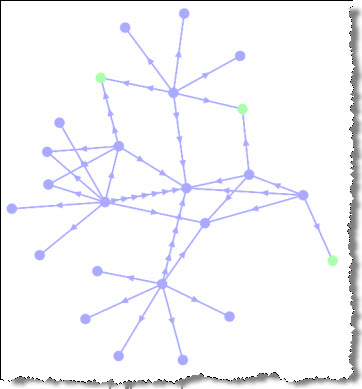
Saved Query Page
If you have saved named queries on the New Query page, you can retrieve them by clicking the saved link of the Queries menu in the page banner. This produces a list of your saved queries.
Note that each query in the list is followed by a small "x" character. Click this "x" to delete the query.
Recent Query Page
The Recent Query page contains a list of your recently-executed queries, which includes your saved queries plus any other queries you ran. Click on an entry in the list to re-run the query.
Text Query Page
The Text Query page is a free-text search form. You get to select the text index to use. If you have not created any text indices, the page will prompt you to do so. Searching here produces a table of matching triples.
Processes Page
This page lists the AllegroGraph processes that are currently running. It is used for debugging AllegroGraph behavior.
To reach this page, click the "Processes" link in Admin menu of the page banner. AllegroGraph can create many subprocesses.
- stacktrace
- This link displays the stacktrace of the process.
- kill
- This link kills the process.
- start telnet
- This link opens a telnet port directly into the eval command loop of the process. This lets an engineer interact directly with the process for diagnostic purposes.
Namespace Selection Page
- My namespaces
- These are namespaces that you have entered in the current repository for your personal use. Add namespace lets you add another namespace to the repository. The "x" icon after a namespace name lets you delete it from the repository.
- Standard namespaces
- These are the namespaces for this repository that are shared among users. Use the checkboxes to the left to enable or disable individual namespaces for this repository.
Replication Page
See the document on Replication and Warm Standby. If there is an active replication server available, this page lets you connect to it and set up a warm-standby triple store on the local server.
